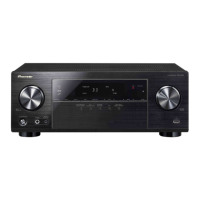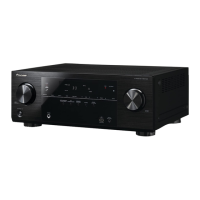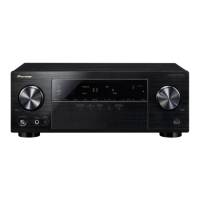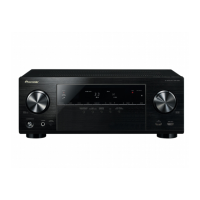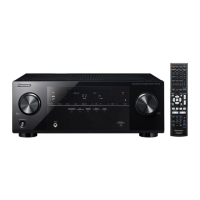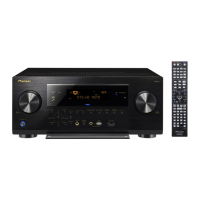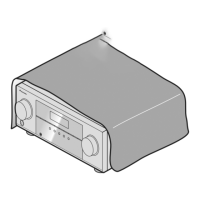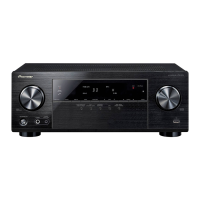
Do you have a question about the Pioneer VSX-524-K and is the answer not in the manual?
| Channels | 5.1 |
|---|---|
| HDMI Inputs | 4 |
| HDMI Outputs | 1 |
| 4K Ultra HD Pass-Through | Yes |
| 3D Ready | Yes |
| Audio Return Channel (ARC) | Yes |
| Dolby TrueHD | Yes |
| DTS-HD Master Audio | Yes |
| MCACC Auto Room Tuning | Yes |
| Bluetooth | No |
| USB Input | 1 |
| Frequency Response | 10 Hz - 100 kHz |
| Total Harmonic Distortion | 0.08% |
| Input Sensitivity/Impedance | 200 mV/47 kOhms |
| Signal-to-Noise Ratio | 98 dB |
| HDMI Version | 1.4 |
| Wi-Fi | No |
| Power Output per Channel | 80 W |
| Audio Inputs/Outputs | 4 In / 1 Out |
Initial steps before operating the receiver, including checking contents and installation.
Step-by-step guide for connecting components and initial settings.
Includes INPUT SELECTOR, MCACC, HDMI, iPod/iPhone indicators.
Buttons for receiver operation, tuning, listening modes, and ECO.
MASTER VOLUME dial and STANDBY/ON button.
PHONES jack and MCACC SETUP MIC jack.
Indicators for PHASE, AUTO, Sleep Timer, and DIR.
Indicators for ST, TUNE, PRESET, MEM, kHz/MHz, DIGITAL, HDMI.
Indicators for speaker status and ADV.S. modes.
Indicators for DTS and Dolby Digital signals.
Buttons for SLEEP, RECEIVER, INPUT SELECT, and Input functions.
SIGNAL SEL, Sound control buttons, Listening mode buttons.
Buttons for accessing menus, tuning, and general navigation.
Buttons for controlling connected components.
Buttons for adjusting bass and treble levels.
Selects radio frequencies, tracks, or other functions.
Controls for adjusting volume and muting sound.
Button to switch the unit's display modes.
Instructions for installing batteries and general precautions.
Important warnings regarding battery handling and usage.
Guidelines for optimal speaker positioning for surround sound.
Ensuring speakers are securely installed to prevent damage or injury.
Step-by-step guide for connecting speaker wires.
Instructions for connecting center and surround speaker wires.
Warnings about hazardous voltage and proper wire connection.
Precautions for bending cables and before making connections.
Notes on using HDMI cables and potential issues.
Receiver's support for various HDMI features.
Notes on HDMI cable requirements and potential issues.
Connecting analog components using RCA cables.
Connecting video components using composite cables.
Connecting digital components using coaxial or optical cables.
Precautions for connecting and storing optical cables.
Connecting components to the receiver via HDMI.
Notes on HDMI connection and OSD display.
Note on analog audio input setup for TV audio.
Notes on analog audio input and optical/coaxial connections.
Diagrams for connecting AM and FM antennas.
Tips for improving FM reception with external antennas.
Tips for improving AM reception with external antennas.
Connecting and controlling an iPod/iPhone via the receiver.
Information on supported iPod/iPhone models and compatibility.
Connecting and playing audio from a USB device.
Safety precautions for handling the power cord.
Note on HDMI initialization process after connecting to AC outlet.
Ensures OSD display for system setup by using composite connections.
Adjusts TV system settings if OSD is incorrect.
Steps for initiating and performing automatic surround sound setup.
Cautions and important notes for MCACC setup.
Steps to access the Home Menu for settings.
Selecting and starting the Auto MCACC setup process.
Waiting for test tones and confirming speaker configuration.
Advice on dealing with noisy rooms or TV interference for MCACC.
Steps to play audio/video from connected sources.
Choosing the correct audio input for playback.
Pioneer's responsibility, compatibility, and usage notes for iPod/iPhone.
Browsing and playing music files from an iPod.
Pioneer's compatibility guarantee and USB device notes.
Steps to resolve USB error messages.
Information on MPEG-4 Advanced Audio Coding.
Information on Windows Media Audio compression.
Memorizing and listening to preset radio stations.
Assigning custom names to saved radio stations.
Selecting various listening modes for different audio sources.
Automatic detection and selection of source playback mode.
Lists suitable sources for different surround modes.
Automatic detection and selection of source playback mode.
Listening modes bypassing signal processing.
Notes that Sound Retriever is only for 2-channel sources.
Phase correction for coherent sound reproduction.
Accessing and adjusting additional sound settings.
Details of available audio settings like EQ, Sound Delay, and Loudness.
Adjusts surround balance and stereo image.
Adjusts center channel effect and dynamic range.
Controls low-frequency bass and SACD gain.
HDMI audio routing and automatic audio-video delay correction.
Steps to access and navigate the Home Menu.
Detailed settings for optimizing surround sound performance.
Specifies speaker size, number, and configuration.
Routing bass frequencies to surround speakers and subwoofer.
Sets crossover frequency between speakers and subwoofer.
Chooses manual or auto adjustment for channel levels.
Adjusts individual channel sound levels.
Sets speaker distances for proper surround sound delay.
Assigns sources to analog input terminals.
Sets automatic receiver power off after inactivity.
Note on interaction between HDMI Standby Through and Auto Power Down.
Configures Audio Return Channel settings.
Sets HDMI output behavior during standby.
Steps for starting ARC operation and initial setup.
Notes on ARC function limitations and CEC control.
Problems with power, automatic shutoff, and HDMI indicator.
Issues with no sound, no picture, subwoofer, or surround speakers.
Problems related to HDMI, ARC, radio noise, and remote control.
Problems with Phase Control, MCACC, and speaker settings.
Troubleshooting a dark display or unresponsive screen.
Troubleshooting issues with iPod touch/iPhone recognition.
Troubleshooting no picture or sound from HDMI connection.
Troubleshooting missing OSD screen with HDMI connection.
Troubleshooting sudden loss of sound with HDMI.
Connecting components directly and using convenient audio connections.
Note on audio output limitations based on display unit channels.
Troubleshooting iPod/USB error codes like 1, 2, 3, and 4.
Message indicating no tracks in the selected iPod category.
Procedure to reset all receiver settings to factory defaults.
Guidelines for cleaning the receiver's exterior.
Technical specifications for the audio output.
Technical specs for tuners, HDMI, and USB.
General specs like power, dimensions, and weight.
List of items included with the receiver.
Technical specifications for the audio output.
Technical specs for tuners, HDMI, and USB.
General specs like power, dimensions, and weight.
List of items included with the receiver.

